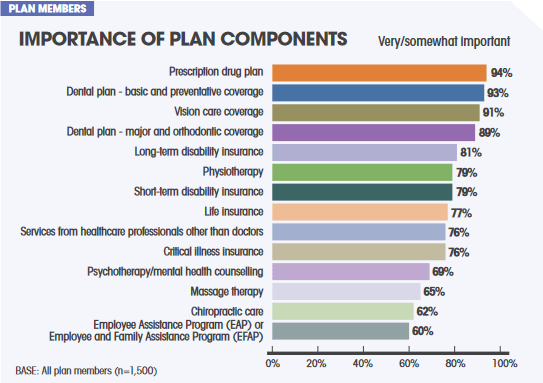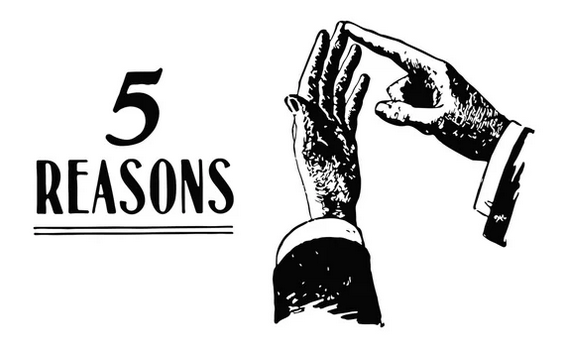Drug benefits are important. The majority (82%) of Canadians with access to health benefit plans used their drug plan at least once in the past year, according to the Sanofi Canada Healthcare Survey. They submitted drug claims an average 9.4 times in the year. That figure rises to 10.9 times for individuals with at least one chronic disease and 14.5 claims for employees in poor health and those who take three or more medications.
Small group and individual health insurance plans cover the cost of prescription drugs — and providing this day-to-day cost management support benefit can be vital to keeping your employees happy and healthy.
If you don’t already offer a prescription drug health plan to your employees, here are five reasons you should.
1. Prescription drug coverage is a highly appreciated benefit

Source: https://opto.ca/sites/default/files/resources/documents/sanofi_2016_healthcare_survey_june_2016.pdf
The Sanofi Canada Healthcare Survey asked plan members to choose what they value most about their health benefit plan. The number one plan component valued is prescription drug coverage. Almost all (94%) employees consider drug coverage very or somewhat important.
Plan members reported submitting an average of 8.0 claims for themselves and 7.7 claims for others when they have prescription drug coverage. When asked to estimate how much their workplace drug plan paid for prescriptions in the past year, members estimated $2,393 for themselves (about $299 per claim) and $2,445 for others ($311 per claim).
If not for prescription drug coverage, those costs would be out-of-pocket for your employees. Drug coverage is a substantial benefit when it comes to an employee’s personal finances.
The onset of COVID-19 reminded us that prescription drugs are essential. According to the Ontario Drug Policy Research Network report on drug utilization during the pandemic, there were medication upticks for:
- Hypertension (a.k.a. high blood pressure)
If high blood pressure is left untreated and remains elevated for a long time, it can be a big problem as it increases the risk for kidney disease, heart disease, heart attacks, strokes, and even death.
- Diabetes
Medications for chronic conditions like diabetes are increasing in usage.
- Asthma
Some individuals are dependent on their rescue inhaler to avoid or lessen the effect of an asthma attack.
The other plus side for employees is that, unlike life insurance, they will typically get to use their drug coverage plan regularly. Depending on their health needs, individuals will use their plan as frequently as every month.
2. It can help your employees stay at work
While including a drug plan will automatically make a benefits package seem more comprehensive and attractive to potential employees, the critical issue is that is can help current employees stay productive.
The consistent finding of the Sanofi surveys year after year is that more than half (58%) of your health plan members report having at least one chronic condition.. In fact, about 70% of employees aged 55 have chronic issues and 93% among those in poor health.
Forty-eight percent of survey respondents report experiencing chronic pain (i.e., pain that never really goes away, or lasts for months, or “flares up” from time to time) caused by conditions like arthritis and diabetes. The top conditions respondents face are mental illness (20%), hypertension (12%), high cholesterol (12%), arthritis (11%), asthma/lung disease (9%) and diabetes (8%) – all of which can be treated with prescription medication.
Health issues have a huge impact on your workforces’ productivity. Left untreated by medications, plan members will miss work or their condition will make it harder to do their job and impact their work performance. Having prescription drug coverage allows employees to address issues promptly and properly, reducing time away from work.
3. Prescription drug plans offer more than just drug coverage

Some health plans with prescription drug coverage may also provide employees with coverage for
- vision care
- registered specialists and therapists including chiropractors, chiropodists, naturopaths, registered massage therapists, physiotherapists, acupuncturists and registered psychologist or psychotherapists
- homecare and nursing or personal support workers, therapists and dieticians
- prosthetic appliances and durable medical equipment
- accidental dental
- accidental death and dismemberment
- ambulance
- hearing aids
- travel medical insurance.
Some individual health plans may also offer add-on benefits like:
- additional medical travel insurance so employees won’t need to buy any other coverage
- extra vision care benefits to increase coverage
- semi-private or private hospital coverage.
And, if you employees have some of these coverages under a group plan, there is no waste. An individual health plan works with group coverage, ‘topping up’ benefits employees use – so they can enjoy fewer out of pocket costs.
Together, the comprehensive range of benefits make an individual prescription drug health insurance plan a strong foundation for an employee benefit program or a valued enhancement to existing group coverage.
More good news for employees is that most pharmacies can submit claims directly to the insurer for reimbursement. This means an employee will only have to show their benefit card to confirm coverage for the prescriptions provided — and they won’t have to pay out of pocket for most of the costs.
4. Offering a plan is easy
Did you know that all of your employees will qualify for an individual insurance plan or a small group plan? As an employer it’s important to offer benefits that all can enjoy.
If an employee has a serious health condition there are guaranteed issue plans available. There are no medical questions asked, and coverage is available for employees 18 years of age and older (and renewable for life).
Plans can cover single employees or their families; children under age 21 can apply as dependents.
Best of all, employees can go online to SBIS and apply for coverage.
5. Its economical
Your employee health plan with prescription drug coverage can also cover dental health benefits, or not. You can control how much you want to fund.
A portion of the health plan insurance premiums may be deductible as a business expense and may also be non-taxable to an employee. The insurer will provide convenient online access so you can print receipts for income tax purposes. It is important to consult with a tax advisor to be certain.
Offering an insurance plan can potentially be more valuable to an employee than a pay increase
Not ready to fund an individual health plan for employees? You can still offer SBIS services directly to your workforce for them to purchase. They will know you have their protection in mind, and we will help them find a plan that suits their needs and budget.
The fact is, health insurance benefits are an important part of any employee’s compensation package. Having the right benefits plan can help your business achieve its goals, attract top talent, and maximize productivity.
Ultimately, it is an opportunity for you as an employer to empower employees to take care of their health – and for you to take care of your business.
Contact SBIS for your free, no-obligation quote or information package now!




